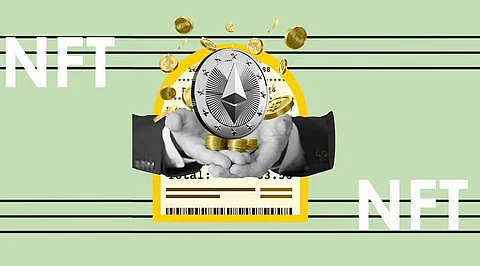

This article will explain how the latest "ERC-4337" Ethereum upgrade will impact the NFT market and what it means for NFT creators and collectors.
ERC-4337 is an Ethereum standard that achieves account abstraction on the protocol without any consensus-layer changes. Deployed on the Ethereum mainnet in March 2023, ERC-4337 makes transacting and creating contracts in a single contract account possible. It opens the door to user-friendly crypto wallet designs that could facilitate broader adoption.
Account abstraction is a long-awaited feature of Ethereum that aims to combine the features of the protocol's two existing account types: externally owned accounts (EOAs) and smart contract accounts. EOAs are owned and controlled by users, while smart contract accounts are smart contracts deployed on the network. Both accounts can receive, hold, and send ether or tokens, but only smart contract accounts can execute code and logic.
Most existing crypto wallets on Ethereum, such as MetaMask, are EOAs, meaning they are limited by the rules set around EOAs. These limitations include solely relying on private keys to access accounts and requiring all transactions to be signed. ERC-4337 allows users to use smart contract wallets containing arbitrary verification logic instead of EOAs as their primary account. This means that users can have more control and flexibility over their transactions, such as using social recovery, customization, upgradeability, multi-factor authentication, automatic payments, and more.
ERC-4337 works by introducing a higher-layer pseudo-transaction object called a UserOperation. A UserOperation is a data structure that describes a transaction to be sent on behalf of a user. Unlike a normal transaction, a UserOperation contains several other fields, such as nonce, gas limit, gas price, fee recipient, signature, and data. The signature field is not defined by the protocol but by each account implementation – the smart contract wallet sending the UserOperation.
A UserOperation is not directly included in a block but instead sent to a special contract called an EntryPoint. An EntryPoint is a singleton contract that executes bundles of UserOperations. Bundlers are nodes (block builders) that can handle UserOperations, create a valid EntryPoint.handleOps() transaction, and add it to the block while it is still valid. This can be achieved in various ways, such as flash bots or proposer-builder separation.
ERC-4337 also introduces a concept of paymasters – helper contracts trusted by accounts to validate an aggregated signature and pay for the gas fees of UserOperations. Paymasters can also implement different fee models, such as sponsored transactions or tokens as gas.
ERC-4337 has several implications for the NFT market and ecosystem. Here are some of the main benefits and challenges of ERC-4337 for NFTs:
ERC-4337 enables more user-friendly and secure crypto wallet designs that can attract more users to the NFT space. Users can have more options and features for managing their NFTs, such as social recovery, customization, upgradeability, multi-factor authentication, automatic payments, and more.
ERC-4337 allows users to pay gas fees differently, such as using tokens or sponsored transactions. This can lower the barriers to entry for NFT creation and trading, especially for users who do not have either or do not want to deal with volatile gas prices.
ERC-4337 supports aggregated signatures (e.g., BLS), which can reduce the size and cost of transactions involving multiple signatures. This can enable more efficient and scalable solutions for NFT minting and transferring.
ERC-4337 requires users to trust bundlers and paymasters to handle their UserOperations correctly and fairly. Users may face censorship, front-running, or malicious behavior from these actors.
ERC-4337 adds complexity and overhead to the protocol and the user experience. Users may need to understand how UserOperations work and how to interact with different bundlers and paymasters.
ERC-4337 does not solve the environmental impact of NFTs on Ethereum. NFTs still consume a lot of energy and generate many carbon emissions due to the proof-of-work consensus mechanism of Ethereum. Users who care about sustainability may prefer solutions like layer 2 scaling or alternative blockchains.
In conclusion, ERC-4337 is an innovative Ethereum standard that achieves account abstraction without consensus-layer changes. It allows users to use smart contract wallets instead of EOAs as their primary account, enabling more user-friendly and flexible crypto wallet designs. It also allows users to pay gas fees differently and supports aggregated signatures for more efficient transactions.
ERC-4337 has significant implications for the NFT market and ecosystem. It can lower the barriers to entry for NFT creation and trading, as well as enable more features and options for managing NFTs. However, it also introduces some challenges and risks, such as trusting bundlers and paymasters, dealing with complexity and overhead, and addressing the environmental impact of NFTs.
ERC-4337 is a promising development for Ethereum and NFTs, but it is not a silver bullet. Users should be aware of the benefits and challenges of ERC-4337 and make informed decisions about their NFT activities.
Join our WhatsApp Channel to get the latest news, exclusives and videos on WhatsApp
_____________
Disclaimer: Analytics Insight does not provide financial advice or guidance on cryptocurrencies and stocks. Also note that the cryptocurrencies mentioned/listed on the website could potentially be scams, i.e. designed to induce you to invest financial resources that may be lost forever and not be recoverable once investments are made. This article is provided for informational purposes and does not constitute investment advice. You are responsible for conducting your own research (DYOR) before making any investments. Read more about the financial risks involved here.
